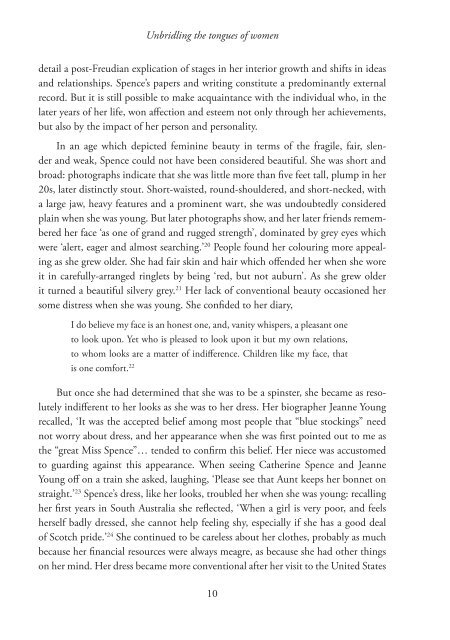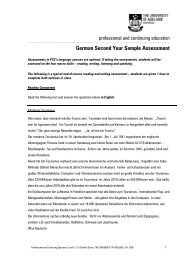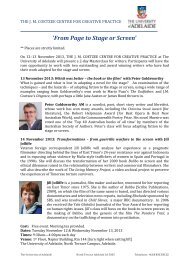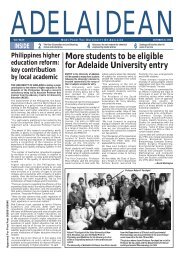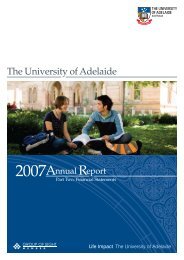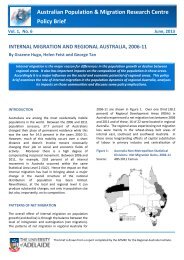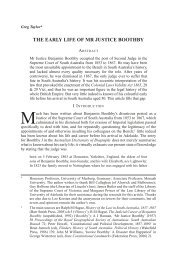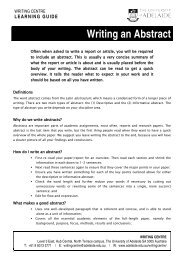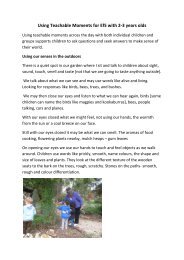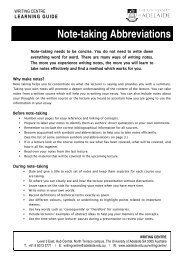Unbridling the Tongues of Women - The University of Adelaide
Unbridling the Tongues of Women - The University of Adelaide
Unbridling the Tongues of Women - The University of Adelaide
Create successful ePaper yourself
Turn your PDF publications into a flip-book with our unique Google optimized e-Paper software.
<strong>Unbridling</strong> <strong>the</strong> tongues <strong>of</strong> women<br />
detail a post-Freudian explication <strong>of</strong> stages in her interior growth and shifts in ideas<br />
and relationships. Spence’s papers and writing constitute a predominantly external<br />
record. But it is still possible to make acquaintance with <strong>the</strong> individual who, in <strong>the</strong><br />
later years <strong>of</strong> her life, won affection and esteem not only through her achievements,<br />
but also by <strong>the</strong> impact <strong>of</strong> her person and personality.<br />
In an age which depicted feminine beauty in terms <strong>of</strong> <strong>the</strong> fragile, fair, slender<br />
and weak, Spence could not have been considered beautiful. She was short and<br />
broad: photographs indicate that she was little more than five feet tall, plump in her<br />
20s, later distinctly stout. Short-waisted, round-shouldered, and short-necked, with<br />
a large jaw, heavy features and a prominent wart, she was undoubtedly considered<br />
plain when she was young. But later photographs show, and her later friends remembered<br />
her face ‘as one <strong>of</strong> grand and rugged strength’, dominated by grey eyes which<br />
were ‘alert, eager and almost searching.’ 20 People found her colouring more appealing<br />
as she grew older. She had fair skin and hair which <strong>of</strong>fended her when she wore<br />
it in carefully-arranged ringlets by being ‘red, but not auburn’. As she grew older<br />
it turned a beautiful silvery grey. 21 Her lack <strong>of</strong> conventional beauty occasioned her<br />
some distress when she was young. She confided to her diary,<br />
I do believe my face is an honest one, and, vanity whispers, a pleasant one<br />
to look upon. Yet who is pleased to look upon it but my own relations,<br />
to whom looks are a matter <strong>of</strong> indifference. Children like my face, that<br />
is one comfort. 22<br />
But once she had determined that she was to be a spinster, she became as resolutely<br />
indifferent to her looks as she was to her dress. Her biographer Jeanne Young<br />
recalled, ‘It was <strong>the</strong> accepted belief among most people that “blue stockings” need<br />
not worry about dress, and her appearance when she was first pointed out to me as<br />
<strong>the</strong> “great Miss Spence”… tended to confirm this belief. Her niece was accustomed<br />
to guarding against this appearance. When seeing Ca<strong>the</strong>rine Spence and Jeanne<br />
Young <strong>of</strong>f on a train she asked, laughing, ‘Please see that Aunt keeps her bonnet on<br />
straight.’ 23 Spence’s dress, like her looks, troubled her when she was young: recalling<br />
her first years in South Australia she reflected, ‘When a girl is very poor, and feels<br />
herself badly dressed, she cannot help feeling shy, especially if she has a good deal<br />
<strong>of</strong> Scotch pride.’ 24 She continued to be careless about her clo<strong>the</strong>s, probably as much<br />
because her financial resources were always meagre, as because she had o<strong>the</strong>r things<br />
on her mind. Her dress became more conventional after her visit to <strong>the</strong> United States<br />
10


